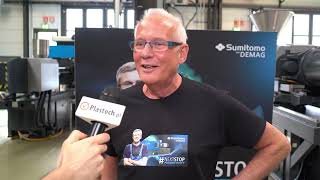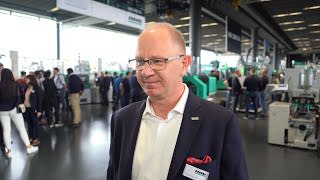These granules are introduced into a plasticizing chamber of a processing machine. Feeders are used to transport the granules from the hopper into the plasticizing chamber. These machines are equipped with a pump that sucks air through a pipe, thus transporting the plastic granules, which subsequently fall into the hopper below. If the plastic materials are sup-plied in bags, this operation takes place close to the machine, moving the material from bag to machine. Where large quantities of plastic material are involved, raw materials is brought in tank trucks and then loaded into silos. In this case, it may be necessary to transport materials for long dis-tances, more than 100 or 150 m and in large quantities, such as 1,000, 1,400 or 2,000 kg/h.
In this case, high power vacuum pumps are employed. With these pumps it is possible to organize systems that use only one vacuum unit able to ensure the continuous transport of granules to a number of processing machines. Of course there is only one vacuum pump with an appropriate power to guarantee the supply of the correct quantity of material for the relevant distance, also taking into consideration flow levels of less smooth materials, with higher quantities for the most difficult transport. These are centralized transport systems. The system is equipped with an electronic device that receives and manages the requests for every single machine. When a machine is not supplied with the minimum quantity of material required for operation, a signal is sent to the electronic system that starts the suction cycle. Each machine is connected to a suitable pipe linked to the machine from one side and to a single material storage from the other side.
When a request for material is received, the vacuum pump starts the cycle intercepting the machine that has requested the material. When another machine asks for material, the blower will transport the material assigned to that machine automatically. In some cases, it is possible to operate 20 processing machines requiring 20 different types of materials.
For the following reasons, transportation criteria for each type of material vary: Type of plastic material, mineral charge, shape, friction coefficient, bulk density, dimension of granules, quantity to be transported, distance to be covered, pipe diameter, pipe height, number of bends to be covered, type of vacuum pump, pump power
There are 13 variables that influence the transport of granules inside the pipes, recommended to operate at a speed of not more than 10-12 m/s on average. As already explained, the parameters for the choice of the trans-port system are decided according to the most complex material. The di-ameter of the pipes and the power of the pump are chosen according to the particular features of one or two of the materials.
Additional material types can not be taken into consideration, as there is only one pump. Even if the power could be changed, synchronization of the calibration for each material – cycle by cycle - would be difficult.



